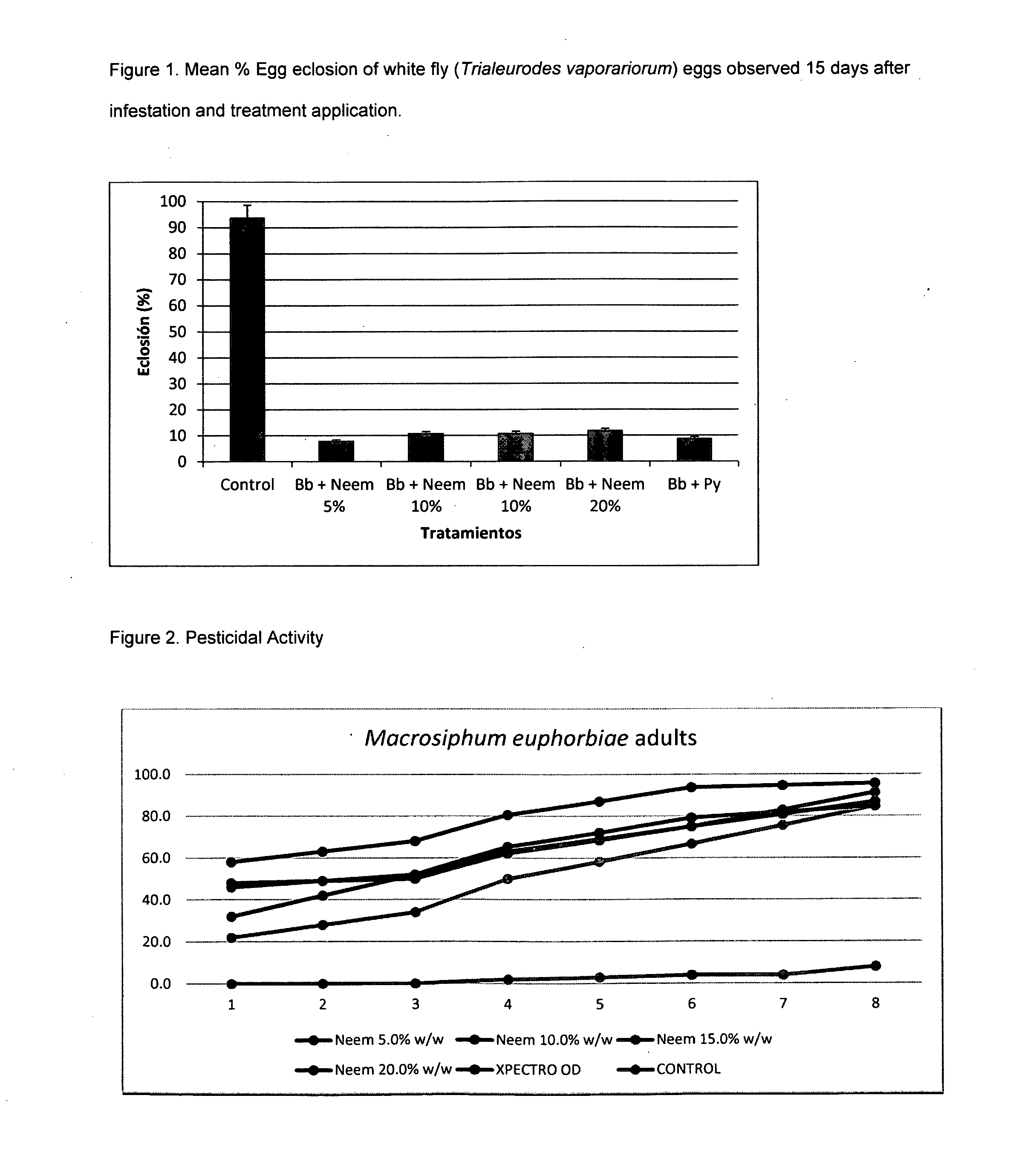Pest control formulation of Neem and Beauveria bassiana and methods of making and using same
- Summary
- Abstract
- Description
- Claims
- Application Information
AI Technical Summary
Benefits of technology
Problems solved by technology
Method used
Image
Examples
example 1
Prevention of Egg Emergence
[0059]This example illustrates the prevention of egg emergence by a composition including neem oil, Beauveria bassiana, and an appropriate surfactant. The prevention of egg emergence is compared among different concentrations of neem of the compositions and to an untreated control group. Solutions comprising neem oil at 5, 10, 15 and 20% by weight, 1×109 spores / ml of Beauveria bassiana strain GHA, and 10.0% ethoxylated nonylphenol oil by weight were prepared with mineral oil as a carrier diluent. Whiteflies eggs laid on tomato leafs (each group with 40 eggs) were sprayed directly with 2.5 ml per liter of each solution. Five replicates for each of the Treated Groups, five negative Control Group, and five positive Xpectro Group, were tested concurrently.
[0060]At a 15 day interval, the number of hatched and unhatched eggs present were counted and compared to other Treated Groups, the Control Group and Positive Control Group. One egg was counted as “hatched” f...
example 2
Pesticidal Activity
[0062]‘Solutions’ containing neem oil at 5, 10, 15 and 20% by weight, 1×109 spores / ml of Beauveria bassiana strain GHA, and 10.0% ethoxylated nonylphenol oil by weight were prepared with mineral oil as a carrier diluent. A dilution was prepared, comprising 2.5 ml of formulations in water. These were applied by spray to leaf surfaces and target pest. Four replicates of each treatment group and of a negative Control Group were tested concurrently. Mortality was observed at specified intervals after infestation. Target insect, rose aphids (Macrosiphum euphorbiae) were counted dead if they were unresponsive when stimulated.
[0063]The percentage of dead aphids was measured at 1, 2, 3, 4, 5, 6, 7 and 8 after treatment and compared against controls. The data collected are summarized in Table 2 and results graphed in FIG. 2. At levels as low as 0.0125% neem oil and 2.5×106 spores / ml of Beauveria bassiana strain GHA the combination demonstrated improved insecticidal activit...
example 3
Insecticidal Knockdown Activity
[0064]This example illustrates the insecticidal knockdown activity of combinations of neem oil or derivatives thereof with Beauveria bassiana against adult aphids, when compared with knockdown activity of Beauveria bassiana alone. Six solutions were prepared: ‘Solution A’ included 5% neem oil by weight, 1×109 spores per ml Beauveria bassiana, and 10% nonylphenol ethoxylate by weight; ‘Solution B’ included 10% neem oil by weight, 1×109 spores per ml Beauveria bassiana, and 10% nonylphenol ethoxylate by weight; ‘Solution C’ included 15% neem oil by weight, 1×109 spores per ml Beauveria bassiana, and 10% nonylphenol ethoxylate by weight; ‘Solution D’ included 20% neem oil by weight, 1×109 spores per ml Beauveria bassiana, and 10% nonylphenol ethoxylate by weight; ‘Solution E’ included 1×1010 spores per ml of Beauveria bassiana by weight and 10% nonylphenol ethoxylate by weight; and ‘Solution F’ included 0.75% Pyrethrins by weight, 1×109 spores per ml Beau...
PUM
 Login to View More
Login to View More Abstract
Description
Claims
Application Information
 Login to View More
Login to View More - R&D
- Intellectual Property
- Life Sciences
- Materials
- Tech Scout
- Unparalleled Data Quality
- Higher Quality Content
- 60% Fewer Hallucinations
Browse by: Latest US Patents, China's latest patents, Technical Efficacy Thesaurus, Application Domain, Technology Topic, Popular Technical Reports.
© 2025 PatSnap. All rights reserved.Legal|Privacy policy|Modern Slavery Act Transparency Statement|Sitemap|About US| Contact US: help@patsnap.com

